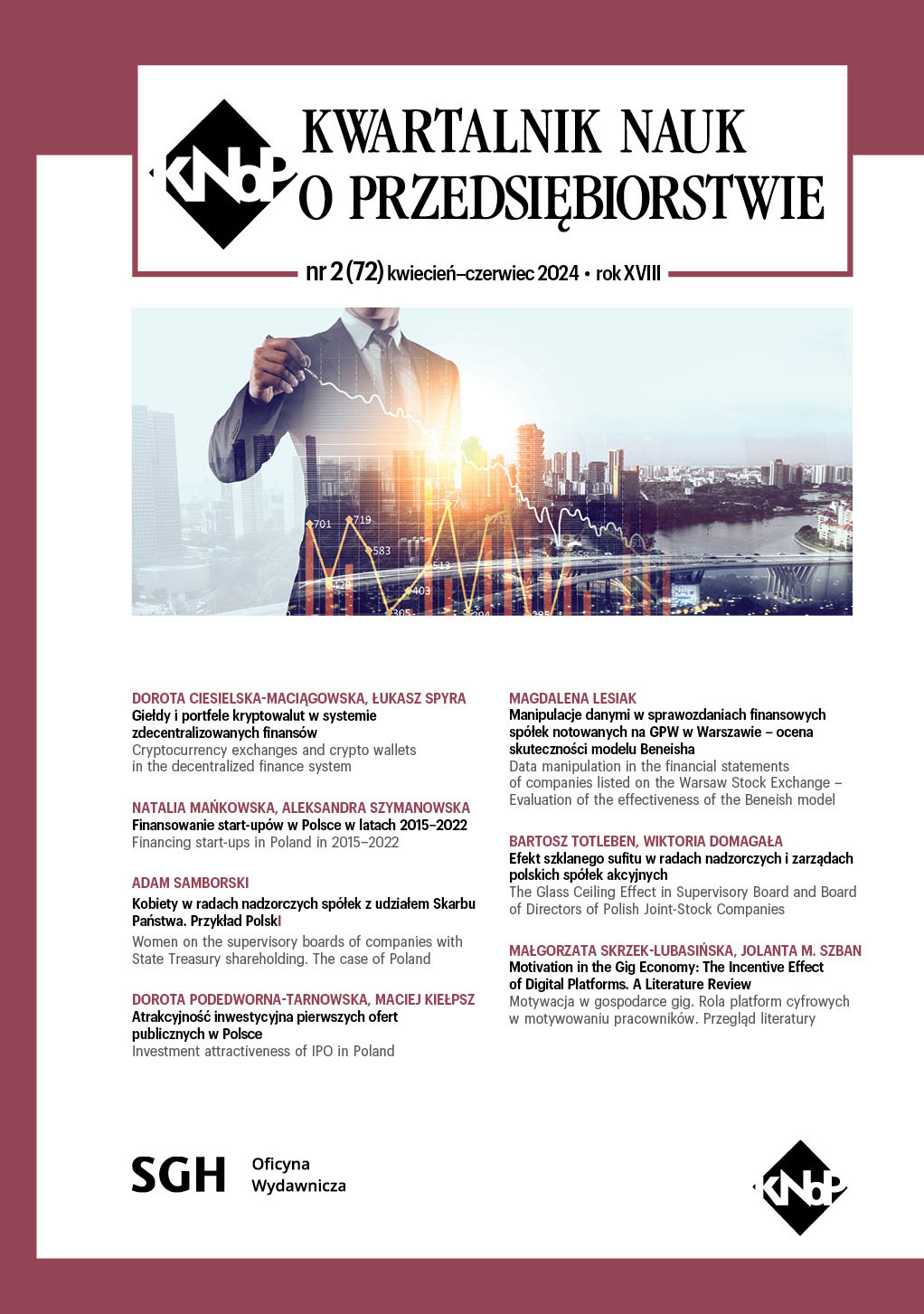Manipulacje danymi w sprawozdaniach finansowych spółek notowanych na GPW w Warszawie – ocena skuteczności modelu Beneisha
Main Article Content
Abstrakt
Celem artykułu jest zweryfikowanie skuteczności modelu Beneisha na polskim rynku kapitałowym. Ocenę skuteczności 8 i 5‑wskaźnikowego modelu Beneisha przeprowadzono zarówno dla jego 8, jak i 5‑wskaźnikowego wariantu przy użyciu krzywej ROC i macierzy pomyłek. Sprawdzono wszystkie trzy wartości graniczne modelu, tzn. –2,22, –1,99 oraz –1,78, których przekroczenie stanowi sygnał potencjalnej manipulacji danymi w sprawozdanych finansowych emitentów z polskiego rynku akcji. Badania łącznie objęły dane z 231 sprawozdań finansowych spółek notowanych na Głównym Rynku GPW oraz NewConenct. W podjętej tematyce badawczej dotychczasowe analizy wykorzystujące dane z polskiego rynku nie obejmowały tak licznej próby badawczej. Wyniki badań wykazały, że w polskich warunkach rynkowych 5‑wskaźnikowy wariant modelu Beneisha cechuje się wyższą skutecznością niż jego 8‑elementowa wersja. Główną praktyczną implikacją badania jest weryfikacja w polskich warunkach rynkowych jednego z najbardziej znanych na świecie modeli wykrywania manipulacji danymi w sprawozdaniach finansowych.
Downloads
Article Details

Utwór dostępny jest na licencji Creative Commons Uznanie autorstwa 4.0 Międzynarodowe.
Autor (Autorzy) artykułu oświadcza, że przesłane opracowanie nie narusza praw autorskich osób trzecich. Wyraża zgodę na poddanie artykułu procedurze recenzji oraz dokonanie zmian redakcyjnych. Przenosi nieodpłatnie na Oficynę Wydawniczą SGH autorskie prawa majątkowe do utworu na polach eksploatacji wymienionych w art. 50 Ustawy z dnia 4 lutego 1994 r. o prawie autorskim i prawach pokrewnych – pod warunkiem, że praca została zaakceptowana do publikacji i opublikowana.
Oficyna Wydawnicza SGH posiada autorskie prawa majątkowe do wszystkich treści czasopisma. Zamieszczenie tekstu artykuły w repozytorium, na stronie domowej autora lub na innej stronie jest dozwolone o ile nie wiąże się z pozyskiwaniem korzyści majątkowych, a tekst wyposażony będzie w informacje źródłowe (w tym również tytuł, rok, numer i adres internetowy czasopisma).
Osoby zainteresowane komercyjnym wykorzystaniem zawartości czasopisma proszone są o kontakt z Redakcją.
Bibliografia
Beneish M. D. [1999], The Detection of Earnings Manipulation, „Financial Analysts Journal”, vol. 55 (5).
Beneish M. D., Lee C. M. C., Nichols D. C. [2012], Fraud Detection and Expected Returns, Working Paper, Indiana University Bloomington.
Comporek M. [2020], The Effectiveness of the Beneish Model in the Detection of Accounting Violations – The Example of Companies Sanctioned by the Polish Financial Supervision Authority, „Prace Naukowe Uniwersytetu Ekonomicznego we Wrocławiu”, vol. 64 (10).
Cyert R. M., March J. G. [1963], A Behavioral Theory of the Firm, Englewoog Cliffs, New York.
Dalecka A. [2015], Użyteczność modelu Beneisha w detekcji manipulacji księgowych, „Zeszyty Naukowe Uniwersytetu Szczecińskiego”, nr 854, „Finanse, Rynki Finansowe, Ubezpieczenia”.
Golec A. [2019], Ocena skuteczności modelu Beneisha w wykrywaniu manipulacji w sprawozdaniach finansowych, „Acta Universitatis Lodziensis. Folia Oeconomica”, nr 2 (341).
Goodpaster K. E. [1983], The concept of corporate responsibility, „Journal of Business Ethics”, vol. 2.
Hołda A. [2020], Oszustwa i manipulacje księgowe a rachunkowość kreatywna, Polskie Wydawnictwo Ekonomiczne, Warszawa.
Hołda A. [2021], Oszustwa i manipulacje księgowe a rachunkowość kreatywna, Polskie Wydawnictwo Ekonomiczne, Warszawa.
Hosmer W., Lemeshow S. [2000], Applied Logistic Regression, John Wiley & Sons, Hoboken.
Instytut Rachunkowości i Podatków, https://irip.pl/poprzednie-edycje (data dostępu: 18.04.2023).
Kumari D., Rajnish K. [2015], Comparing Efficiency of Software Fault Prediction Models Developed through Binary and Multinomial Logistic Regression Techniques, w: Mandal J. K., Satapathy S. C., Sanyal M. K., Sarkar P. P., Mukhopadhyay A. (red.), Information Systems Design and Intelligent Applications, Proceedings of Second International Conference India, 1, Springer.
Marinakis P. [2011], An investigation of earnings management and earnings manipulation in the UK (Doctoral dissertation), University of Nottingham.
Rappaport A. [1995], Shareholder Value. Wertsteigerung als Massstab für die Unternehmensführung, Schäffer – Poeschel Verlag, Stuttgart.
Sylwestrzak M. [2022], Application of the Beneish Model on the Warsaw Stock Exchange, „Journal of Banking and Financial Economics”, vol. 2 (18).
Wiszniowski E. [2020], Accuracy of the Beneish Model as Applied to Polish Enterprises Known to Manipulate Financial Reports, w: Soliman Khalid S. (red.), Education Excellence and Innovation Management: A 2025 Vision to Sustain Economic Development during Global Challenges, International Business Information Management Association (IBIMA).
Wykaz kar KNF za lata 2006–2022.
Zestawienie sankcji nałożonych przez Organizatora ASO na emitentów NewConnect, w związku z nieprzestrzeganiem przepisów Regulaminu ASO – stan na 30 września 2022 r., https://newconnect.pl/pub/NEWCONNECT/zastawienie_sankcji/NEWCONNECT_zestawienie_sankcji_092022.pdf (data dostępu: 30.09.2023).

